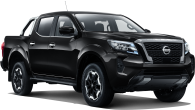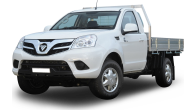The Mazda BT-50 had a difficult birth as a Ford Ranger clone in 2011, largely because its elaborate styling didn't seem to know if it was meant to be a car or a truck. However, over the near-decade that has followed, Mazda has done a commendable job through styling tweaks in making the BT-50 look more truck-like and pleasing to the eye.
After all, we've never heard of someone refusing to buy a vehicle because it's too good-looking, so this was the correct path for Mazda to follow. And even though the current generation is nearing the end of its life cycle, a recent week behind the wheel confirmed that it remains a competent all-rounder in Australia's competitive ute market.
Mazda BT-50 2020: Xtr (4X4) (5Yr)
| Engine Type | Diesel Turbo 5, 3.2L |
|---|---|
| Fuel Type | Diesel |
| Fuel Efficiency | 10.0L/100km (combined) |
| Seating | 5 |
| Price From | $30,910 - $37,290 |
| Safety Rating |
|
Does it represent good value for the price? What features does it come with?
Our test vehicle is the 4x4 dual cab XTR which with 3.2-litre five-cylinder turbo-diesel engine and six-speed torque converter automatic transmission has a list price of $54,950 plus ORC. That pricing slots neatly between lower-grade 4x4 dual cab auto equivalents like the Ford Ranger XLS ($51,890) and XLT ($58,840) or Toyota HiLux SR ($49,515) and SR5 ($57,240) model grades.
The XTR also splits the BT-50's base-grade XT ($49,840) and premium-grade GT ($58,830), offering a happy medium in price, extra features and a more upmarket look than the base model on which it's based.
.jpg)
So, for the $5110 extra spend over the XT, the XTR adds 17-inch alloy wheels with road-biased 265/65 R17 tyres and a full-size steel spare, chrome door handles, chrome power door mirrors and chrome rear-step bumper, tubular polished aluminium side-steps, halogen fog lights, auto on-off headlights and rain-sensing wipers.
Inside,there's a leather-wrapped steering wheel and gearshift knob, carpet, dual-zone climate control, auto-dimming rear-view mirror and 8.0-inch touchscreen with sat-nav (including off-road maps) for the infotainment system, which like the XT features Apple Car Play/Android Auto and multiple connectivity.
Is there anything interesting about its design?
Over time we've found the BT-50 looks best in dark colours, so we reckon our test vehicle in Deep Crystal Blue Mica with contrasting chrome and polished alloy highlights looks pretty sharp.
Little has changed under the skin as it's still an authentic Ranger clone from 2011. Its body is mounted on a separate steel ladder-frame chassis with coil-spring independent front suspension, leaf-spring live rear axle, hydraulically-assisted rack and pinion steering and front disc/rear drum brakes.
.jpg)
It has a 12.4 metre turning circle and off-road credentials are still competitive in this segment, with up to 237mm of ground clearance, 800mm wading depth, 28 degrees approach angle, 25.0 degrees ramp break-over angle and 26 degrees departure angle.
Being based on the XT it's pretty plain inside, although acres of grey are broken up by tasteful splashes of chrome and satin chrome. The polished side-steps and big grab handles on the A-pillars make for easy front cabin entry and with a well-placed left footrest, height-adjustable steering wheel and manual seat lumbar adjustment, it's not hard for large adults to find a comfortable and spacious driving position.
.jpg)
For those seated in the rear stalls, there are no B-pillar grab handles but the side-steps combined with decent-sized pathways between the B-pillars and rear seat base cushion make for easy entry and exit.
However, rear seat headroom is limited for tall adults, with barely a finger's thickness between top of head and roof lining. It's even less for those seated in the middle, adding to discomfort caused by rubbing shoulders and having to place feet either side of the transmission tunnel with knees together to clear the front seat backrests. Like most dual cabs, you can carry three adults in the rear, but realistically only on short trips.
.jpg)
What are the key stats for the engine and transmission?
A Euro 5-compliant 3.2-litre inline five-cylinder turbo-diesel shared with the Ranger is the only engine available in the BT-50 yet one of its best attributes. This low-stressed unit churns out 147kW at 3000rpm and 470Nm of torque between 1750-2500rpm.
The six-speed automatic transmission features Active Adaptive Shift (AAS) intelligence that optimises the selection of its gears to suit different driving styles. There's also a Sport mode for snappier acceleration and the option of sequential manual shifting, which is ideal for heavy load-hauling and exploiting the turbo-diesel's excellent engine-braking on steep descents.
The 4x4 transmission is dual-range, part-time. You can select high-range 4x4 on the move plus the 2.718:1 low-range reduction via a dial on the console. Another console button electronically locks the rear differential.
.jpg)
How much fuel does it consume?
Mazda claims an even 10L/100km for the XTR with auto and the dash display wasn't far north of that figure at 11.3 when we stopped to fill the tank, after 327km of testing which included just under 120km at near-maximum payload.
Our figure based on actual fuel bowser and tripmeter readings was 11L/100km, which is good economy given the heavy load-hauling and lots of city and suburban driving during our test. So, based on our figures which are line-ball with the BT-50's, you could expect a real-world driving range from its 80-litre tank of around 730km.
How practical is the space inside?
The XTR auto's 2105kg kerb weight and 3200kg GVM results in a genuine one tonne-plus payload rating of 1095kg. It's also rated to tow up to 3500kg of braked trailer but with its 6000kg GCM (or how much it can legally carry and tow at the same time) there's devil in the detail.
Fact is, if you want to tow 3500kg you would have to reduce that handsome 1095kg payload by a whopping 700kg top avoid exceeding the GCM. And that would only leave 395kg of payload capacity, which could easily by used up by four large adults with no gear.
.jpg)
It's also a fact that few owners this side of a RAM or Silverado need to tow 3500kg, so it's more practical and safer to base braked towing limits on the tow vehicle's GVM. In this case 3200kg, which drops the XTR's towing limit from 3500kg to 2800kg (still a big figure) but preserves all of its 1095kg payload rating without exceeding the GCM limit.
The XTR cargo tub's load floor is 1549mm long and 1560mm wide with 1139mm between the wheel housings, meaning it can't fit a standard 1165mm-square Aussie pallet but can take one 1200 x 800mm Euro pallet. There's six load anchorage points, but no bulkhead frame to protect the rear window.
.jpg)
Cabin storage options include a large bottle holder and small bin in the base of each front door, another storage nook in the centre dash-pad, an overhead glasses holder, glove box and centre console with open storage at the front, two small bottle/cup holders in the centre and a lidded box at the back.
Rear seat passengers get a bottle holder and small bin in each door, a small storage pouch on the rear of the front passenger seat's backrest only (should be on both seats) and two small bottle/cup holders in the pull-down centre armrest. The rear seat's base cushion also swings up through 90 degrees and can be stored vertically for more internal cargo space, or to access two shallow hidden storage bins below.
.jpg)
What's it like as a daily driver?
We've always enjoyed driving the BT-50 and the MY20 edition hasn't changed that view. Although it hasn't shared in the numerous updates enjoyed by the Ranger during their lifetimes, it has maintained some desirable traits.
We particularly like the firm and responsive feel of the hydraulic power-assisted steering (Ranger moved to an electric system with PXII) and the effortless engine performance. In city and suburban driving, it just loafs along with a relaxed gait that requires no more than 1500-2500rpm to maintain its momentum. It has the same laid-back feel at highway speeds, with the big turbo-diesel needing only 1750rpm at 100km/h and 2000rpm at 110km/h.
On bumpy roads the ride when empty or lightly loaded can be jiggly, but that's to be expected given the suspension stiffness required to handle its one tonne-plus payload rating. It has a quiet cabin environment at highway speeds too.
What's it like for tradie use?
We loaded 890kg into the cargo tub which with driver equalled a payload of around 1040kg, which combined with the tow-bar weight was less than 60kg short of the 3200kg GVM limit.
The rear springs compressed a full 60mm under this load and the nose rose 10mm in response. However, that left less than 20mm of static bump-stop clearance in the rear suspension. As a result, we felt the rubber-softened thud of the rear suspension bottoming out through some of the larger dips and over some of the larger bumps on our test route.
For most driving under this maximum loading, though, the BT-50 was its usual competent self. Maintaining highway speeds required little mechanical effort, with the engine always operating within the 1750-2500rpm peak torque band where it does its best work.
.jpg)
The BT-50 also showed its strengths on our 2.0km-long, 13 per cent gradient set climb at 60km/h. It waltzed up in third gear, so we tried it again in fourth. With the accelerator pressed to the floor, the engine dropped to 1600rpm before gradually building speed and pulling this taller gear all the way to the top, which was impressive given the load on its back.
Engine-braking on the way down in a manually-selected second gear was equally strong, spinning up to 4250rpm on overrun (4900rpm redline) without once exceeding the signposted 60km/h limit or us needing to touch the brake pedal.
That's the best engine-braking you'll get this side of a Land Cruiser 70 Series, which is 1.3 litres larger in capacity with three more cylinders. It's another reminder of the inherent advantage of larger cubic displacement engines (3.0 litres-plus) when it comes to lugging heavy loads, both up and down hills.
.jpg)
Warranty & Safety Rating
What safety equipment is fitted? What safety rating?
Has a five-star ANCAP rating, albeit achieved at launch back in 2011 with its Ranger twin. Unlike the Ford, however, the BT-50 has not kept pace with the latest safety upgrades like AEB, lane-keeping assist, parking sensors etc. And the rear seat has two top tether child restraint anchor points but no ISOFIX.
Even so, it does come with front/side airbags for driver and front passenger plus side curtain airbags front and rear. The stability control menu is also tailored for load-carrying, including trailer sway control, load adaptive control, electronic brake-force distribution, emergency brake assist, hill descent control and hill launch assist. There's also a reversing camera.
What does it cost to own? What warranty is offered?
The BT-50 is covered by Mazda's Five years/unlimited km warranty, including five years premium roadside assistance. Service intervals of 12 months/15,000km whichever occurs first. Capped-price servicing costs of $2402 for the first five years of scheduled services.
Verdict
After almost a decade of service, the BT-50 is still a competent all-rounder in the local 4x4 dual cab ute battle and armed with a competitive warranty. So, if best-in-class safety is not a priority and you're looking for an all-terrain one-tonner that's a cut above a base model, then the mid-spec XTR is a well-rounded package worthy of consideration.
Pricing Guides

Range and Specs
| Vehicle | Specs | Price* |
|---|---|---|
| Gt (4X4) | 3.0L, Diesel, 6 SPEED AUTOMATIC | $37,400 - $44,000 |
| Gt (4X4) | 3.0L, Diesel, 6 SPEED MANUAL | $32,450 - $38,610 |
| Xt (4X2) | 3.0L, Diesel, 6 SPEED AUTOMATIC | $26,070 - $32,120 |






.jpg)
.jpg)













.jpg)
.jpg)



.jpg)